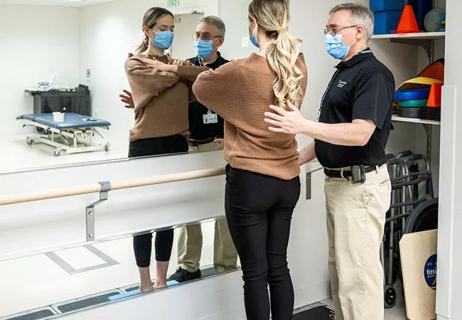Research on children with UHL explores the quality-of-life benefits and outcomes of cochlear implants
During her 15-year career at Cleveland Clinic, Samantha Anne, MD, medical director of Pediatric Ear and Hearing Disorders, has witnessed a profound transformation in newborns and children who receive hearing aids, cochlear implants and other treatments.
Advertisement
Cleveland Clinic is a non-profit academic medical center. Advertising on our site helps support our mission. We do not endorse non-Cleveland Clinic products or services. Policy
“What excites me about [caring for] children with hearing loss is it’s something that we can easily address and really make an impact on their quality of life,” says Dr. Anne. “We have so much to offer these children so that they can live their lives as if hearing loss is not part of the equation.”
In a recent episode of Cleveland Clinic’s Head and Neck Innovations podcast, Dr. Anne talks about pediatric unilateral hearing loss. She discusses:
Click the podcast player above to listen to the episode now, or read on for a short edited excerpt. Check out more Head and Neck Innovations episodes at clevelandclinic.org/podcasts/head-and-neck-innovations or wherever you get your podcasts.
Dr. Anne: In the past, if you had a hearing loss on one side, they would put you in front of the classroom, put the good ear facing the teacher and you're good to go. However, the evidence out there is that these children with unilateral hearing loss still struggle with speech and language, and behaviorally they start to fall behind in school and sometimes need to repeat the grades. So, now we're a lot more aggressive about treating these children.
Advertisement
We've looked at both the evaluation and the impact of unilateral hearing loss. The most recent research has focused on cochlear implantation (CI) for unilateral hearing loss. CI for UHL has been FDA-approved within the past five years. So, there's very limited data and evidence on how these children do, and it really is a big mystery.
There are so many variables that come into play in terms of if children with UHL benefit from cochlear implantation or not. We find some children who have had unilateral hearing loss for a very short period of time, they're very young and we do implantation, and the children are not wearing their implants. For some reason they don't like them – they take them off.
And then there's children who you would not expect good results from because they've had prolonged duration of deafness, and they're older and we do implantation on them, and they love their implants and they're wearing it every day. And there's a considerable amount of research and efforts going into trying to figure out what makes these children do well with their implants, what makes these children want to wear them and what are the variables that cause these children to be high risk for non-use.
That's been the focus of our research in the last few years, and most recently trying to tease out all these variables that can impact CI outcomes in children with UHL – looking at age of hearing loss, duration of deafness and quality of life impact. Most recently the impact of streaming, meaning direct input of sound into the deaf ear with an implant to try to force that ear to work. Looking at all these variables has been the focus of our research.
Advertisement
Advertisement

Study shows no negative impact for individuals with better contralateral ear performance

Expanded patient criteria and surgical advances mean more patients can benefit

Recommendations look to change mindset with CI referrals

When a patient failed to improve, the value of a comprehensive vestibular test was apparent

Case study illustrates the potential of a dual-subspecialist approach

Evidence-based recommendations for balancing cancer control with quality of life

HNS device offers new solution for those struggling with CPAP

Patient with cerebral palsy undergoes life-saving tumor resection